Binoculars for Landscape Observation: A Guide for Landscape Photographers
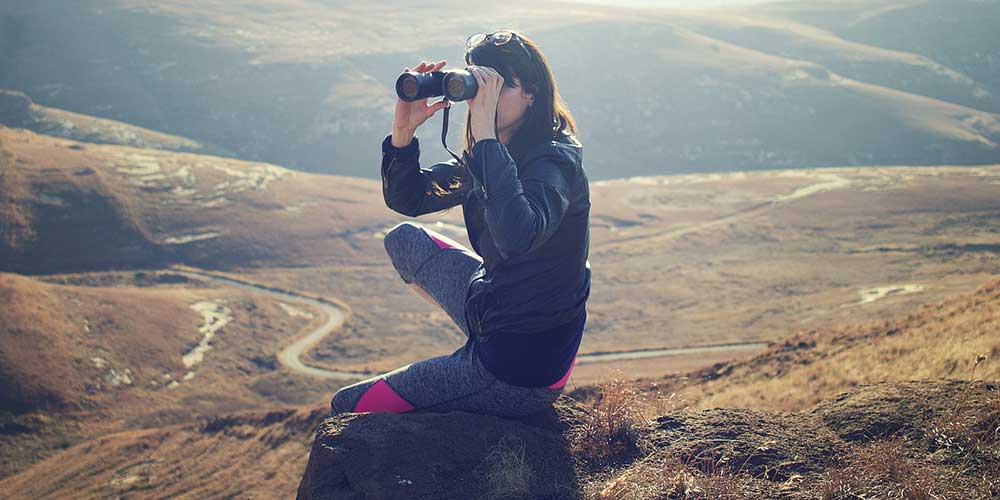
When it comes to choosing binoculars for landscape observation there are a range of factors that are important to consider when deciding which model will be best suited to your landscape observation requirements. In this article we will consider the wide range of observation binoculars on the market in New Zealand and help you to understand the key factors that you need to consider when choosing the best binoculars for long distance viewing and also the best binoculars for the money that you wish to spend. We’ll also touch on which binoculars will make the best model for locating and taking photos of stunning landscapes through your smart phone.
Binoculars for landscape viewing come in all shapes and sizes and, unlike buying binoculars for other activities such as birding, there’s no hard and fast way to group binoculars for landscape observation. This is because the type of binocular observation of the landscape that you plan to do can vary dramatically. For example, you may need to observe a landscape whilst out in the bush on a hunt to scan for animals. In this case, it’s unlikely the animals will be more than 1km away so a standard hunting binocular configuration of 8x or 10x42 will be great. Or, you may want to observe the ocean from your home to see whales migrating at a distance of 2km to 3km. In this situation, more high powered binoculars such as a 18x or 20x that require a tripod may be a better option to get a closer look. If you’re going to be using the binoculars to enjoy stunning landscapes and views whilst hiking then portability will likely be important, so opting for small binoculars may be a necessity. In this situation, it will be vital to find a balance between models that offer high magnification whilst still producing bright clear images.
Due to the vast potential of requirements when choosing the best binoculars for landscape viewing and taking subsequent photos of those landscapes through them, we’re going to suggest binocular models in a couple of different size and magnification brackets so that there is something to suit the most common settings where binoculars may be used for landscape viewing and photography. This means that we’ll have some higher magnification models for zoomed in landscape viewing, or for more distant, wider shots of sweeping landscapes there will be lower magnification models. For all models we’ll be considering their magnification, objective lens size, field of view, weight and portability, along with their quality and performance. All models we suggest will offer the best value for money in their class.
Our Top Picks for Landscape Binoculars
High magnification and large lenses:
Vortex Kaibab HD 18x56 Binoculars
Vortex Diamondback HD 15x56 Binoculars
Nikon Aculon A211 16x50 Binoculars
Mid magnification and standard sized lenses:
Zeiss Conquest HD 8x42 Binoculars
Vortex Viper HD 8x42 Binoculars (2018)
Vanguard Endeavor ED IV 8x42 Binoculars
Vortex Crossfire HD 8x42 Binoculars
Nikon Aculon A211 8x42 Binoculars
Mid magnification and mid sized lenses:
Nikon Monarch M7 ED 8x30 Binoculars
High magnification binoculars for landscape viewing
The binocular models suggested below have magnifications on the higher end of the range which make them ideal for static viewing from a tripod. Their high magnifications reduce the amount of the landscape that you can see at one time, magnifying just one area in quite a lot of detail. This means that they’re great for getting an up close look at distant landscapes and enjoying observing or photographing that area in more detail.
Vortex Kaibab HD 18x56 Binoculars
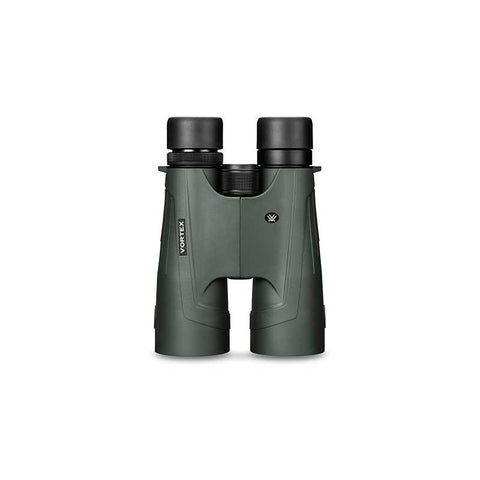
Our top pick from our high powered binocular range, these awesome binoculars from Vortex offer 18x magnification and large 56mm objective lenses making them some of the best long range binoculars for bird watching, animal watching and viewing boats and more from afar. They’d be great atop a tripod in any home to get closer views of enjoyable vistas and possibly photograph them. Their high definition lenses offer incredible brightness thanks to a range of multi-coatings. Not the cheapest binoculars on the market, but by far the best in their class for viewing from afar.
Key Features:
- 18x magnification power
- 56mm objective lenses
- Fully multi-coated lenses
- HD lenses
- APO lens system
- Twist up eyepieces
- Dielectric multi-layer prism coatings
- ArmorTek ® scratch-resistant coating
- Waterproof
- Comes with tripod adapter
- Comes with special neck strap and body harness
- Non slip rubber armour
- 16.4mm eye relief
- 3.1mm exit pupil
- 59m field of view
- 1233g
Pros:
- Powerful 18x magnification gets you up close
- High definition lenses with XR Plus multi-coating deliver the highest level of light transmission Multi-layer dielectric prism coatings increase image brightness and clarity
- Incredible Vortex warranty
Cons:
- Not the cheapest binoculars
- On the heavier side so should be used with a tripod
- Due to the configuration of magnification and lens size, the exit pupil of these binoculars is quite small so they are best used in the day
- Will provide a close up view of landscapes but as they are quite high magnification the field of view isn’t huge
Vortex Diamondback HD 15x56 Binoculars
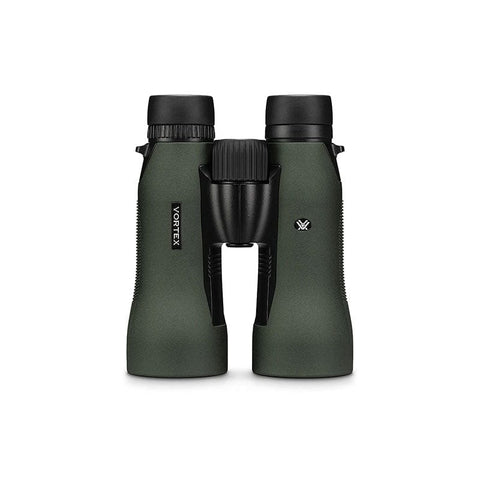
Part of American brand Vortex’s ever popular Diamondback range, these binoculars have HD lenses that are best in class for their price range and they come with an incredible Vortex warranty. They have a relatively high magnification which means they’ll be best used with a tripod. A 70m field of allows for close up viewing of landscapes whilst still being able to see quite a large portion of it. For wider, sweeping views opt for lower magnifications.
Key Features:
- 15x magnification power
- 56mm objective lenses
- Fully multi-coated lenses
- HD lenses
- Dielectric multi-layer prism coatings
- ArmorTek ® scratch-resistant coating
- Waterproof
- Tripod adaptable
- Comes with special neck strap and body harness
- Non slip rubber armour
- Twist up eyepieces
- 15mm eye relief
- 3.7mm exit pupil
- 70m field of view
- 986g
Pros:
- Great quality optical coatings
- High definition glass
- Rugged and durable
- Just enough eye relief if you wear glasses
- Comes with a tripod adapter
- Comes with special binocular harness and carrying case
- Amazing Vortex warranty
- Weight isn’t too bad for their size
Cons:
- Glass isn’t as good quality as some of the higher end models but fantastic for the price
Nikon Aculon A211 16x50 Binoculars

The Nikon Aculon 16x50 binoculars are an affordable long range, binocular option. The carefully configured lens and magnification size of this model means that you can view in high power without too much fatigue from their weight. A tripod would make for steadier views. This budget option are great for people who are just getting started.
Key Features:
- 16x magnification
- 50mm objective lenses
- Twist up eyepieces
- Multicoated optics
- 73m field of view
- 12mm eye relief
- 3mm exit pupil
- 924g
Pros:
- Not too heavy
- Rubber armoured for protection
- Multicoated optics produce bright images
- More affordable than other models
Cons:
- Not waterproof
- Eye relief could be better
- Mid quality glass compared to higher end models
Mid magnification binoculars for landscape viewing
If you love a good sweeping view of a stunning landscape, and you want to be able to see as much of it as possible, then opting for slightly lower magnification binoculars will allow you to do just that. Thanks to the configuration of lower magnification and lens size, many standard or full sized binoculars that have lenses of around 42mm in size, offer a wider field of view which means that you can see more of the landscape at one time. These models of binoculars are great if you wish to connect your phone or camera to the binoculars and get broader shots of the landscape rather than more zoomed in ones.
Zeiss Conquest HD 8x42 Binoculars
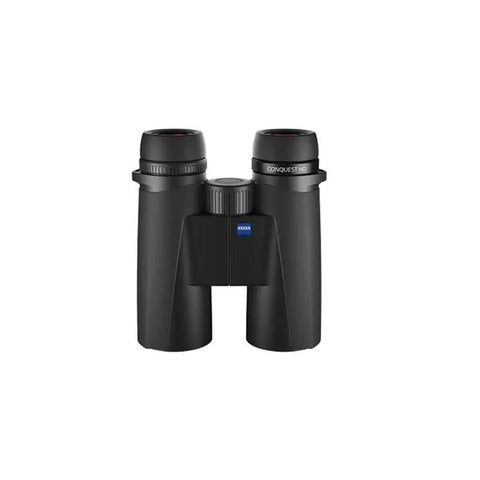
The Conquest binoculars have HD lenses and produce bright, clear images. Made in optical leading Germany, they feature some of the best quality glass on the market. They have a fantastic field of view which allows you to see more of the landscape at one time than other similar models. A long eye relief makes them a great option for people who wear glasses. They’re at the higher end of the price range but offer exceptional viewing and photography opportunities.
Key Features:
- 8x magnification
- 42mm objective lenses
- Made in Germany
- HD lenses
- LotuTec® lens coating
- 128m field of view
- 18mm eye relief
- 1.9m close focus
- Waterproof
- 794g
Pros:
- Made in Germany
- HD lenses for bright, clear images
- Lens coating to repel water
- Good eye relief for those who wear glasses
- Wide field of view for wide landscape views
Cons:
- Higher end of price range
- Slightly on the heavier side
Vortex Viper HD 8x42 Binoculars (2018)

The Viper binoculars from Vortex offer HD lenses and a fantastic quality build. They’re not only optically brilliant, they also have a durable and comfortable-to-use construction that’s lightweight too. The eye relief of these models makes them a great option for eyeglass wearers. The wide field of view will allow you to see up to 124m of the landscape in front of you at one time.
Key Features:
- 8x magnification
- 42mm objective lenses
- High definition glass
- Fully multicoated optics
- Waterproof
- ArmorTek ultra-hard, scratch-resistant lens coating
- 1.9m close focus
- 18mm eye relief
- 124m field of view
- 694g
Pros:
- HD glass for bright and clear images
- Good weight
- Good eye relief for eyeglass wearers
- Scratch resistant lenses
- Wide field of view of enjoying landscapes
- Great all rounder
- Exceptional warranty
Cons:
- Close focus could be better if you want to use for close up viewing too
Vanguard Endeavor ED IV 8x42 Binoculars

Offering the widest field of view of our roof prism binoculars in this round up, these awesome Vanguard Endeavors will allow you to see more of the landscape at once than any other model on offer. They also have an exceptional glass quality for their price point which means that views and any subsequent photos will be crisp and clear.
Key Features:
- 8x magnification
- 42mm objective lenses
- Extra low dispersion lenses
- Fully multicoated optics
- 126m field of view
- 2m close focus
- 19mm eye relief
- 786g
Pros:
- Good price point for the quality
- HD lenses
- Good eye relief
- Wide field of view for viewing landscapes
Cons:
- The close focus could be better
Vortex Crossfire HD 8x42 Binoculars
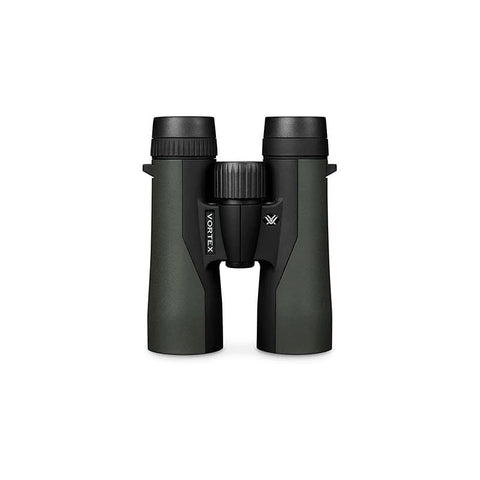
Known for their exceptionally priced high definition optics, Vortex include HD glass in this 8x binocular model, meaning that they offer crisp, clear, colour true images with little distortion, for a great affordable price. They offer a good sized field of view for enjoying landscapes.
Features:
- HD optical system
- Fully multi-coated lenses
- Waterproof
- Rubber armour
- Adjustable eye cups
- Centre focus wheel
- Diopter adjustments
- Tripod adaptable
- 17mm eye relief
- 1.8m close focus
- 114m field of view
- 786g
Pros:
- Great affordable option that comes with HD glass
- Decent eye relief for eye glass wearers
- Durable and ready for the outdoors
- Great binoculars if you want expensive features at an affordable price
- Awesome Vortex warranty
- Come with special binocular carry case
- Good field of view
Cons:
- Could be more lightweight
Nikon Aculon A211 8x42 Binoculars
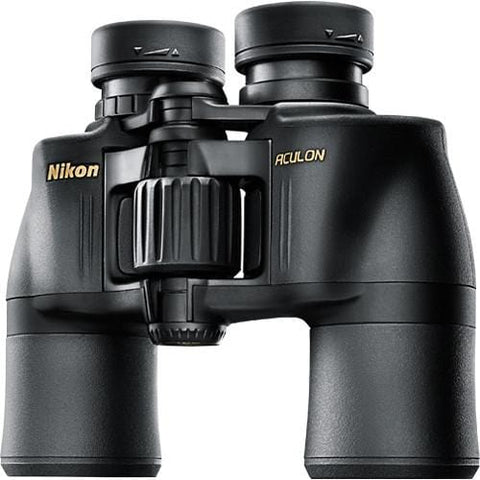
The Nikon Aculon A211 8x42 Binoculars have a porro prism design which, by its nature allows them to produce a wider field of view than roof prism models. These binoculars perform well optically for their price however their porro prism design makes them more bulky than other models. They’re not fully waterproof so you’ll need to decide if you need the wide field of view or whether durability would be more important.
Features:
- BAK4 porro prisms
- Multicoated optics
- Centre focus wheel
- Twist-up rubber eyecups
- Rubber armoured housing
- 12mm eye relief
- 5m close focus
- 139m field of view
- 760g
Pros:
- Very wide field of view
- Perform well optically for their price thanks to a porro prism design
- The most affordable option in our round up
Cons:
- Not waterproof
- Porro prism design makes them more bulky
- Very minimal eye relief
Mid magnification and mid-sized binoculars for landscape viewing
If you’re planning on using your new binoculars whilst on the move, whether that’s out hiking in the hills or hunting on the plains, then keeping them as lightweight as possible is really important. In these cases, having slightly smaller, 30mm or 32mm lenses will keep the size and weight of the binoculars down so that you have less to carry. Binoculars of this size may not perform as well in low light conditions as their counterparts with lower lenses, so it’s important to opt for a binocular with good enough lens coatings to improve image quality.
Nikon Monarch M7 ED 8x30 Binoculars

These exceptional 30mm binoculars from Nikons world famous Monarch line are built with an incredible optical system. Extra low dispersion (ED) glass virtually eliminates common distortion, chromatic aberrations and colour fringing resulting in clear, high-resolution views in nearly any lighting condition. They offer a very wide field of view and an incredibly low weight thanks to their mid sized lenses and mid range magnification.
Key Features:
- 8x magnification
- 30mm lenses
- Extra low dispersion glass
- Waterproof
- 15.1mm eye relief
- 2m close focus
- 132m field of view
- 464g
Pros:
- Due to their 30mm lenses they’re much more compact than larger models and weigh a lot less
- ED lenses produce bright clear images
- Rugged design
- Great compact design is easy to handle on the move
- Very wide field of view offers great landscape views
Cons:
- Not as much eye relief as some models
Kowa SV-32 II 8x32 Binoculars

The Kowa SV II 8x32 Binoculars are compact and lightweight making them ideal for observing on the move. Ideal for bird and nature watching, sailing, safari and enjoying all the scenery and landscapes on the way. An ultra wide field of view allows you to see lots of the landscape at once.
Features:
- 8x magnification
- 32mm objective lenses
- Polycarbonate inner body for light but strong construction
- Waterproof and fogproof
- KR coating enhance the performance of the lens and make for easy cleaning
- Twist-up eye cups
- Right-eye dioptric correction
- Phase coating
- Fully multicoated optics
- Tripod adaptable
- One-piece tethered ocular rain guard
- 148m field of view
- 15.5mm eye relief
- 4m close focus
- 564g
Pros:
- Ultra wide field of view means you can see heaps of the landscape in one view
- Decent optics with plenty of lens coatings for brightness and clarity
Cons:
- Could be lighter
- The eye relief wouldn’t be great for eye glass wearers
How to Pick the Best Binoculars for Landscape Observation
As we’ve already discussed, picking the best binoculars for landscape viewing comes down to a range of factors that depend closely on the activity and location that you plan to use the binoculars in. Due to this, there are a couple of buying factors that will depend on your situation, such as the magnification and objective lens diameter you choose, and there are also other factors that have a more universal affect on what you should choose. We’ll consider these below in two parts.
Factors that depend on your viewing situation:
Magnification
Every binocular has a magnification factor which refers to the degree that it enlarges the apparent size of the object or landscape that you are viewing. The magnification of every binocular on our website is shown as a number in the binoculars name and is represented as a number followed by "x" (e.g., 8x, 10x, 12x). This number tells you how many times larger the object appears compared to the naked eye when viewing through that binocular. So, if you are to view an object through a ten times magnification binocular that is 100 meters away, it will appear as if it is only 10m away.
The best magnification of a binocular for landscape viewing varies dramatically depending on how far away the landscapes are that you want to view, where you plan on viewing from, and whether or not you want to use a tripod. Below we’ll take a look at the binocular magnification best suited to a few common viewing situations. It’s important to note that a higher magnification isn’t always better than a lower one, and that the more magnification you have, the less of the landscape you can see at once, and the more effect any slight shake of the hand will have on the images.
Best binocular magnification for viewing and photographing landscapes at a long distance from the home
If you’ve got a stunning ocean, mountain or city view from your home that’s located a long distance away but that you want to enjoy in more detail, then binoculars are a great option for immersing yourself in it. If you only plan on using the binoculars from one location in your home, and you aren’t bothered about transporting them very far, but you do want to get a much closer view of long distant views that are usually too far away to see, then you’re in a great situation for using long range binoculars alongside a tripod. Long range binoculars come in a range of sizes, but if portability isn’t an important factor to you, then opting for some of the most powerful binoculars we have available could be a great option to get some incredibly magnified views. The most important factor to remember is that if you’re opting for high magnifications then you also need a large objective lens. This will ensure that the images are bright enough for you to see. Binoculars with a configuration of 18x56 are great models for these situations as they offer a decent amount of magnification and have nice large lenses for bright, clear views, even at dusk. If you want even higher magnifications then it’s important to pair them with large lenses. Spotting scopes are a great option for these situations as they offer even higher magnifications paired with a large objective lens. Spotting scopes are a bit like telescope binoculars as they are designed for land based viewing but offer much higher, zoom magnifications so you can see both wide landscape views on lower settings and in much more detail at higher magnifications, even at long distances. Another beauty of spotting scopes is that they are often even easier than binoculars to connect to either a smart phone or a DSLR camera to capture stunning landscape shots. You can check out all of our digiscoping equipment here, or contact us with the make and model of your DSLR camera and we’ll find out what specific camera adapters you need.
Best binocular magnification for viewing landscapes when bird watching or hunting
When you’re out bird watching or hunting, you’ll often find yourself panning the landscape to find the next animal or bird of interest. Many birders or hunters also utilise a spotting scope for this activity, so having binoculars for this specific task isn’t always necessary. For any birding or hunting we’d always suggest binoculars with either an 8x, 10x or 12x magnification. All of these magnifications should allow for the viewing of animals or birds of interest but offer a fine balance in that they aren’t too susceptible to image shake. Any of these magnifications will also work really well for taking bright, clear photographs of the landscape through the binoculars.
Best binocular magnification for viewing landscapes when hiking
When you’re out hiking it’s important to keep your kit as lightweight as possible. With this in mind, opting for more compact or mid sized binoculars for your observations is important. When you opt for binoculars with smaller lenses, it’s important to choose models that have magnifications on the lower end to ensure that the images they produce remain bright and clear. If you’re choosing binoculars for these situations then we’d advise choosing models with an 8x magnification such as 8x32 models. These models will allow you to get a great look and potentially photograph the landscapes you see.
Objective lens diameter
The objective lens of a binocular is located at the front of the unit and its job is to let light into the binoculars where it can then travel to your eye. Objective lenses come in a range of different sizes and are commonly paired with certain magnifications to make for the very best viewing. The size of the objective lens of a binocular affects a range of factors including how bright the images that the binocular produces are and also how bulky and heavy the binoculars are. In addition, the size of the objective lens and the magnification it is paired with will have a bearing on the field of view offered by the binoculars. When it comes to choosing the right objective lens diameter to suit your needs the two main things to ask yourself are, “How portable and lightweight do I need the binoculars to be?” and “What time of day will I be using the binoculars?”. If you need portable binoculars then opt for 42mm lenses or below. If you need binoculars that work really well in the low light conditions of dusk and dawn then you’ll need those with lenses of 42mm or larger.
Factors that everyone should consider when choosing binoculars for landscape viewing:
Field of view
The field of view of a binocular refers to the amount of the landscape that you can see at one time when looking through them. This is typically measured in meters and it varies between binoculars depending on their magnification, objective lens size and also their overall design and construction. When it comes to viewing and photographing landscapes, the larger the field of view the better. This means that you’ll see more of the landscape of interest in one frame. In general, binoculars of a lower magnification and with larger objective lenses will have a wider field of view. If seeing and photographing long sweeping landscapes is important to you then keep an eye on the width of the field of view of the binoculars that you’re choosing between as they often vary even between binoculars which, on the surface, appear to have the same specifications.
Lens coating
One factor that has a huge affect on the performance of a binocular is the lens coatings that are applied to its lenses. Lens coatings play a crucial role in enhancing the performance of them. Lens coatings are applied to the glass surfaces of the lenses of binoculars to improve image quality, reduce reflections, and enhance light transmission. Depending on the construction quality of a binocular, it may have lenses that are ‘coated’ and just have one layer of anti reflection coatings applied to one lens, ‘fully coated’, where all lenses have one coating on them, or ‘fully multicoated’ where all lenses have more than one coating. The latter option of ‘fully multicoated’ is always preferable as these will perform better than others when it comes to reducing unwanted reflections, improving image brightness, and enhancing overall image quality. In addition, they can significantly improve the clarity, contrast, and colour accuracy of the images you observe through your binoculars.
Prism type
Binoculars come in two main designs. Porro prism binoculars are made from two prisms which are positioned at a right angle to each other meaning that the objective lenses and eye pieces are not aligned, and roof prisms which have straight barrels where the objective lens and eyepiece are inline with each other. Both types of binoculars are suitable for landscape viewing and photography however each has it’s pros and cons that you may want to consider when choosing the best binoculars for your needs. In general, porro prism binoculars are bulkier than roof prism binoculars, so if weight and portability are key factors then roof prisms will be the best option in most cases. They are also harder to make waterproof so aren’t as durable. On the flip side, porro prism binoculars generally offer a wider field of view, so if getting the widest possible view of a landscape at a certain magnification is vital for you, then they may be the best models for you.
Tripod adaptable
If you’re opting for binoculars with a magnification higher than 15x then we’d suggest using them with a tripod to prevent the images from being negatively affected by image shake. To do this, you’ll need to be able to mount them on a tripod with an adapter for a secure connection. Most binoculars of higher magnifications are configured to connect with tripod adapters to mount on a tripod and require adapters that are specific to their brand and design. These adapters can usually be purchased as an accessory and don’t usually come as part of a binocular package.
Eye relief
Eye relief is a term used to describe the distance that you can hold binoculars away from your face whilst still being able to comfortably see the full view through them, without dark and circles starting to appear around the outside of the image. Eye relief is measured in mm and can typically vary from between 11mm and 20mm depending on the design of the binocular and the size of their objective lenses. For most people, the eye relief of a binocular isn’t of huge importance, but if you wear eye glasses then it is a game changer. If you’re looking for landscape binoculars to use whilst wearing eye glasses then it’s vital that you look for a model with an eye relief of 16mm or above. You can find out more here in our blog about choosing binoculars to use with glasses.
Image stabilisation and steady images
The steadiness of the images you view through a binocular is mainly a result of a combination of magnification power and hand shake. Everyones hands shake a little. If you then magnify this 10x or 20x when using a binocular, the image shake can be very noticeable and make it really hard to see anything through the binoculars. To combat this, opt for lesser magnification binoculars if you want to hold them with your hands or use a tripod for higher magnification options. You could also consider buying image stabilised binoculars which use special technology to counter the shake of your hands.
Durability
When choosing binoculars we always suggest opting for the most durable models available to ensure that they can withstand the great outdoors. Many stunning landscapes to view and photograph are off the beaten track in the Kiwi wilderness, so it’s vital that your binoculars are waterproof and rubber armoured to ensure they can take whatever the weather may throw at them.
Digiscoping adapters
Now that we’ve taken an in depth look at the factors to consider when choosing the binoculars themselves for enjoying landscape views and potentially photographing them through the binoculars, it’s about time we looked at ways to connect your phone or camera to the binoculars. For most smart phones, choosing this adapter is the easiest part of the set up, and opting for a universal adapter such as this one from Carson, or this one from Vanguard is a simple and fantastic solution to digiscoping with your phone. When it comes to choosing digiscoping adapters for DSLR cameras it gets a bit more tricky so it’s usually best if you contact us to find out how we can help.
Enjoy the View With Binoculars From ScopeUout
If you’re looking to use binoculars to enjoy the stunning landscapes on offer in New Zealand, whilst potentially taking a few photographs of them too, then you’re in the right place to find a quality binocular to suit your needs. As we have discussed, there are a wide range of binoculars that are suitable for landscape viewing, and it’s up to you to decide which will suit your needs best. If you’re looking for close up landscape views, then opt for high magnification binoculars and pair them with a tripod. Want more sweeping, broader views of the stunning skylines of NZ and don’t mind a little bit of weight? Opt for an 8x42 model for landscape views and also great performance for activities including hunting and birding. If you want to keep things as lightweight as possible whilst still maintaining a wide field of view to enjoy landscapes and to capture stunning images of them then a mid sized 8x30 or 8x32 model will be your best friend.
We’re a small, family run and incredibly trust worthy Kiwi business. We’ve been helping Kiwi’s like you to buy the very best binoculars for their needs since 2014 and we pride our selves on being as helpful and informative as possible. If you need any help at all selecting the right binoculars for you then check out our binocular buying guides and give us a shout if you need any further advice. We’re always happy to help! Check out all of the binoculars suggested above or you can view our full range here. Buy with confidence today and be rest assured that all of our products are covered by a NZ manufactures warranty.





Leave a comment